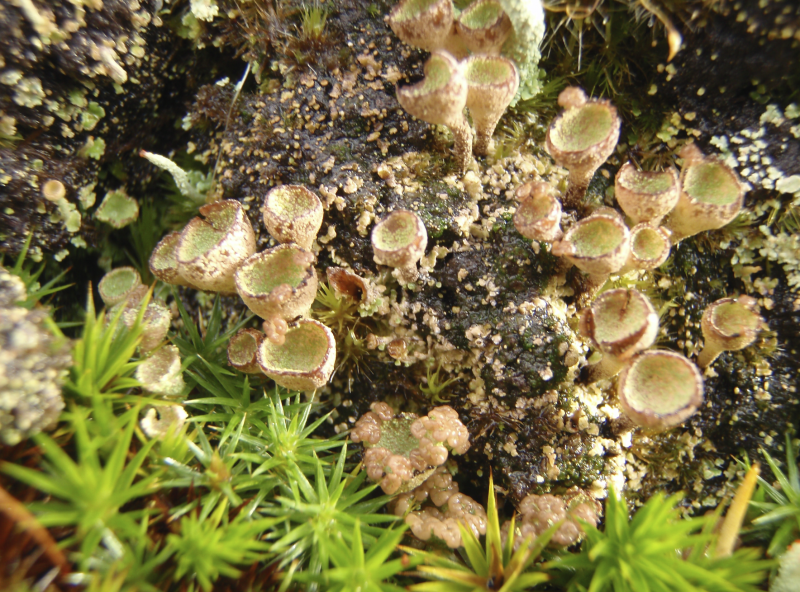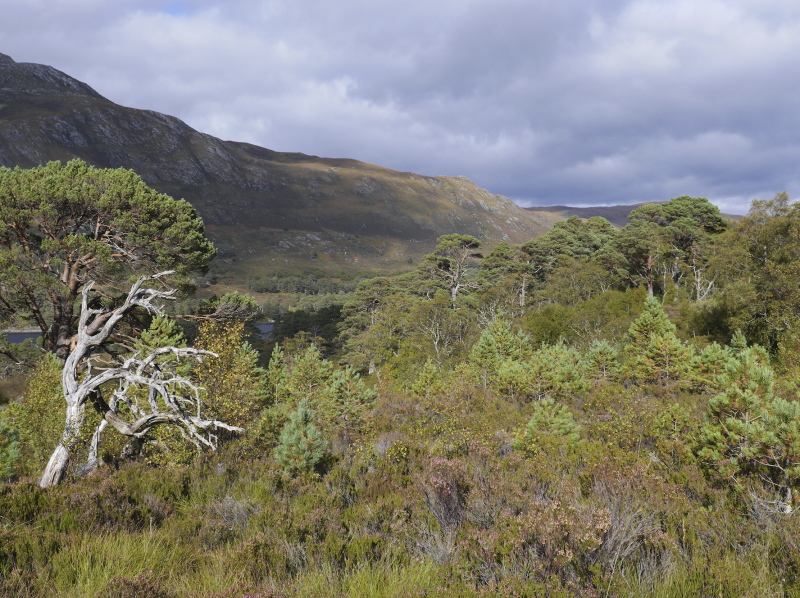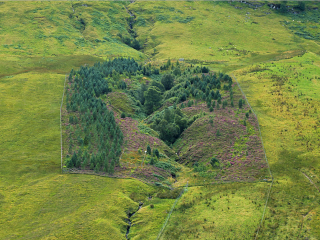Ecological succession
When the glaciers retreated from the Highland glens at the end of last Ice Age, how did that barren, glacier-scoured wilderness of rock eventually become rich and varied woodland? The answer is succession, the natural process in which communities of vegetation develop and change over time.
 Lichens play a key role in the early stages of succession, accessing minerals in bare rock and helping to begin the process of creating soil. Mosses and grasses can then get established, along with annual and perennial herbs, then shrubs, pioneer woodland, and after centuries, the ‘climax’ vegetation of mature woodland. This is a simplified overview, and the plants that colonise will be affected by environmental conditions such as soil type and wetness, altitude, the number of herbivores, and which seed sources are nearby. However, the general trend in succession is for dominant plants in the earlier stages to be herbaceous annuals, and for those in later stages to be slow-growing woody perennials.
Lichens play a key role in the early stages of succession, accessing minerals in bare rock and helping to begin the process of creating soil. Mosses and grasses can then get established, along with annual and perennial herbs, then shrubs, pioneer woodland, and after centuries, the ‘climax’ vegetation of mature woodland. This is a simplified overview, and the plants that colonise will be affected by environmental conditions such as soil type and wetness, altitude, the number of herbivores, and which seed sources are nearby. However, the general trend in succession is for dominant plants in the earlier stages to be herbaceous annuals, and for those in later stages to be slow-growing woody perennials.
A typical pattern in many upland sites, for instance overgrazed acid grassland, will include species such as wavy hair-grass being present early on. If grazing is reduced, dwarf shrubs like ling and blaeberry can colonise and in certain conditions dry heath begins to develop. Then pioneer trees arrive on the scene including rowan and birch. These have developed strategies for travelling long distances: rowan with the assistance of birds tempted by its berries, and birch with the aid of the wind. Birch improves the soil, paving the way for the climax woodland to follow. Climax trees are characteristically long-lived species such as Scots pine and sessile oak.
 Climax woodland is not the end of the story. Large, natural forest ecosystems are dynamic and diverse thanks to disturbance by wind, fire and disease, as well as the presence of herbivores and carnivores such as the wolf. With a large enough area of forest there will be patches at every stage of succession, each with its own suite of wildlife. While completely bare areas of ground are not common, they do exist, sometimes due to a landslip. Bare earth warms up quickly and can support a range of specialist invertebrates, such as digger wasps and the green tiger beetle. Annual flowers such as devil’s-bit scabious provide nectar for various bees and butterflies. Heather benefits a range of species including the northern eggar moth and red grouse, while the dark bordered beauty moth can be found on the young suckers of aspen. Pioneer shrub and tree species, including juniper and birch, have their own range of associated species. Siskin are partial to birch seeds, and birch also supports large numbers of insects, including aphids, which are themselves an important food source for other wildlife.
Climax woodland is not the end of the story. Large, natural forest ecosystems are dynamic and diverse thanks to disturbance by wind, fire and disease, as well as the presence of herbivores and carnivores such as the wolf. With a large enough area of forest there will be patches at every stage of succession, each with its own suite of wildlife. While completely bare areas of ground are not common, they do exist, sometimes due to a landslip. Bare earth warms up quickly and can support a range of specialist invertebrates, such as digger wasps and the green tiger beetle. Annual flowers such as devil’s-bit scabious provide nectar for various bees and butterflies. Heather benefits a range of species including the northern eggar moth and red grouse, while the dark bordered beauty moth can be found on the young suckers of aspen. Pioneer shrub and tree species, including juniper and birch, have their own range of associated species. Siskin are partial to birch seeds, and birch also supports large numbers of insects, including aphids, which are themselves an important food source for other wildlife.
Succession is a key process in a healthy forest, and given a chance woodland can regenerate itself.
As the vegetation reaches its climax, earlier stages may die out due to shade, but generally speaking, habitats get more diverse over time, and climax woodlands are especially rich ecosystems. In a really old and unmanaged woodland there is a lot of dead and dying wood which is used by a whole host of species including fungi, insects such as the pine hoverfly, and hole nesting birds including the crested tit. Twinflower and other pinewood plants replace moorland species on the ground layer.
Humans have had a huge influence on succession for millennia, and if our influence were removed, woodland would spring up over a lot of the Highlands. Activities such as eliminating top predators, overgrazing and excessive burning all prevent climax vegetation from developing; this is known as arrested succession. In extreme cases reverse succession occurs when overgrazing pushes a woodland back towards acid grassland, and even to bare, eroded peat ‘hags’.
 This is why fences and deer control play an important role in encouraging natural regeneration. If the site is too remote for natural regeneration, it can be helpful to make informed predictions about the woodland type that might develop in an area. By working out what the climax vegetation would be, based on, for example, the existing vegetation and soil conditions, we can choose appropriate species to plant. For example, the presence of heather and blaeberry on mineral soils are good indicators that pine woodland would develop under natural conditions.
This is why fences and deer control play an important role in encouraging natural regeneration. If the site is too remote for natural regeneration, it can be helpful to make informed predictions about the woodland type that might develop in an area. By working out what the climax vegetation would be, based on, for example, the existing vegetation and soil conditions, we can choose appropriate species to plant. For example, the presence of heather and blaeberry on mineral soils are good indicators that pine woodland would develop under natural conditions.
Succession is a key process in a healthy forest, and given a chance woodland can regenerate itself. However, to have really healthy, dynamic ecosystems with all stages of succession present, we would need to establish large areas of forest, ideally with a range of large herbivores and carnivores, so that a wider range of natural processes can take place.

